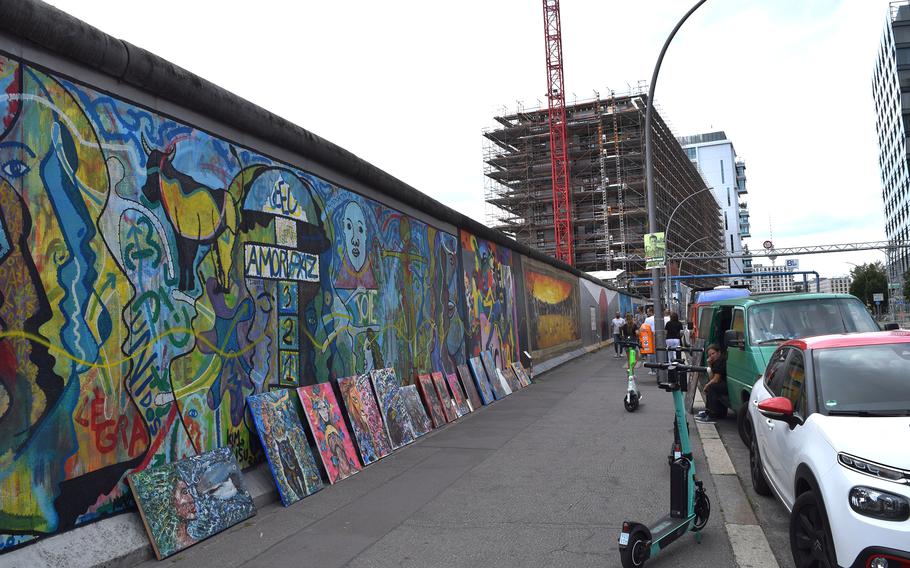
A high-rise construction project looming over the East Side Gallery, an open-air art exhibit created from the Wall’s longest intact stretch, highlights, to some, the relentless takeover of Berlin by global capitalism. (Gabriel Popkin/The Washington Post)
In bustling Berlin, one can easily miss the inconspicuous parallel rows of cobblestones that cut across city streets, sidewalks and plazas. They mark where the Berlin Wall, for 28 years, divided neighbors, friends and families, keeping East Germans behind the Iron Curtain. And though a single, ugly concrete wall is what West Berliners mainly saw - and painted defiant graffiti on - the wall was far more than that: It included several high-tech barriers, regularly spaced guard towers and a "death strip" up to 500 feet wide where tripwires alerted soldiers with orders to shoot would-be escapees. Some 140 people died at the wall.
Then, starting Nov. 9, 1989, and proceeding faster than anyone thought possible, it fell.
Some wanted to fill the space and forget the wall ever existed. But a forward-thinking politician and avid biker named Michael Cramer helped ensure that didn't happen, eventually persuading the Berlin Senate to instead create a 100-mile hiker-biker trail that follows the perimeter of the former West Berlin, which forms something like an irregular triangle: the Mauerweg (Wall Trail). This year, while on a two-month fellowship, I found myself living in an apartment just half a block from the trail. I was intrigued to see what had taken the place of the Cold War's most formidable symbol, so I stepped outside on a late-September day, hopped on the barely serviceable bike I had been riding around Berlin and set out.
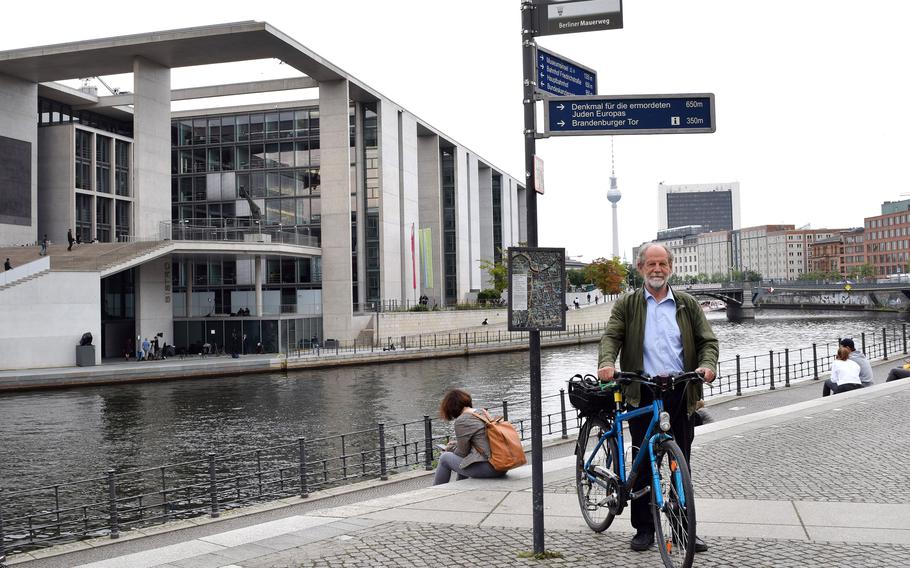
Former politician and avid cyclist Michael Cramer led the push to create the Mauerweg and keep the Wall from fading into history. (Gabriel Popkin/The Washington Post)
My home base was the Wrangelkiez section of Berlin's Kreuzberg neighborhood, which despite being in the southeast quadrant of the city, ended up in West Berlin when the city was divided. I was soon rumbling alongside a canal that formed part of the old border. During the wall days, this neighborhood was "the end of the world" for West Berliners, making it undesirable for most but a vibrant haven for hippies and immigrants - a mix that persists, albeit in gentrified form. On warm days, locals flood the canal banks to bask in sunshine and hold barbecues and outdoor concerts. The path then cuts through quieter residential neighborhoods and one of the highly regulated community gardens where millions of urban Germans flee on weekends. Many such gardens were cleaved by the wall. Now, the Mauerweg offers an up-close look at this often-hidden but utterly essential aspect of German culture.
The trail is mostly paved, though I occasionally found myself biking on packed dirt, gravel or (the worst) bone-jarring cobblestones. Every turn is marked by distinctive gray-and-white signs posted at the wall's former height of around 13 feet. There are no official statistics on how many people ride the Mauerweg, Cramer told me in a phone interview, but it figures in countless commutes, exercise routines and weekend excursions. As I rode out of town, I shared the path with joggers, walkers, sport and casual riders. Germany was enjoying a relative (and sadly temporary) respite from the pandemic, so things felt extremely "normal." One guy blasted heavy metal from a speaker on his handlebars. Just another Saturday in Berlin.
The wall didn't just split Berlin. It also cut West Berlin off from the neighboring, largely rural state of Brandenburg. Here I entered a landscape of woodlands, wetlands, small farms and open meadows where sheep and cows graze. I passed a birch woods where two rather rough-looking guys were foraging for mushrooms - still a common German pastime. A bit later, I came upon a disheveled fellow affixing ID numbers to trees for the local government. In Germany, where most forest land is devoted to timber production, the former death strip has become a rare place where natural forests can grow unimpeded.
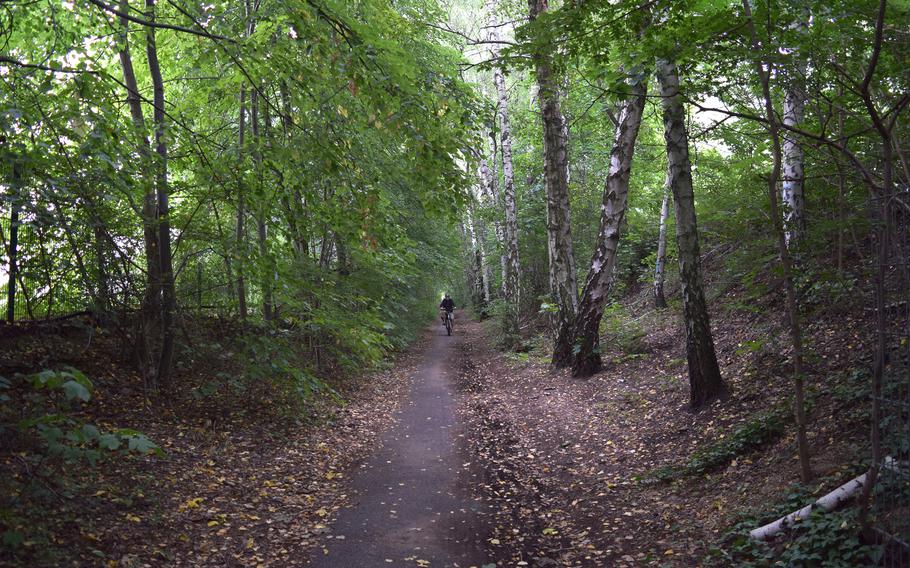
White-barked birch trees are a familiar sight in woods that have sprung up along the route. (Gabriel Popkin/The Washington Post)
Indeed, the death strip has become a life strip, and not just people and trees but wildflowers, bees, butterflies and birds have benefited. One study found some 250 different plants, including a number of threatened ones, growing here. At another site, researchers counted 19 wild bee species.
As the sun set, having covered some 40 miles, I reached the posh suburb of Potsdam. Though not as absolute as the Berlin Wall, the private fences, hedges and walls that hem in the streets here are no more traversable. All ideologies, it seems, build walls.
I finally arrived at Pension am Tiefen See, where I had booked a modest room. After dinner at a nearby restaurant, I passed out from exhaustion. I awoke to a sumptuous buffet breakfast: fruit, cheeses, meats, smoked fish, eggs, grilled vegetables, grilled quark (a German specialty), yogurt, marinated vegetables, all washed down with coffee. I ate perhaps more than is prudent, but I figured I would need fuel for the day ahead. I even squirreled away a hard-boiled egg for later.
In back of the hotel is a houseboat docked on the Tiefer See (Deep Lake) that also has guest rooms. The proprietor is from Estonia and opened the hotel in 2003. Like virtually everyone I spoke to on this trip, she moved here after the wall's fall to take advantage of the opportunities afforded in a reunited Germany.
From Potsdam I crossed the Glienicke Bridge, where the United States and Soviet Union once exchanged spies, and biked a pleasant route through woods to the Wannsee, where I boarded a public ferry. The weather had turned sunny and warm, and sailboats dotted the water. After I disembarked, I started on what is probably the loveliest stretch of the trail. For one thing, there were finally hills. Though taxing on my ponderous bike, they added interest and variety. I came upon a beautiful lake tucked into the forest, with a tiny beach populated by a few dozen locals. I couldn't resist taking a dip. The cold, clear water felt almost impossibly refreshing. As I dried off, I ate my picnic lunch - and this being Germany, got a quite decent cup of coffee from the beachside stand. Then, with a twinge of jealousy toward the locals lounging on the beach, I packed up; the rest of the Mauerweg called.
Though the ride itself is pleasant, reminders of the Berlin Wall's grim past are everywhere. Sections of the wall have been preserved in various places, along with five guard towers, one of which, in the town of Hennigsdorf, northwest of Berlin, is open for a brief tour. Memorials at the site of each victim's death offer photos, biographies and stories of attempted escapes in both English and German. Almost all victims were men, most were young, and many seem to have made the fateful decision to flee on a whim, as young men sometimes do.
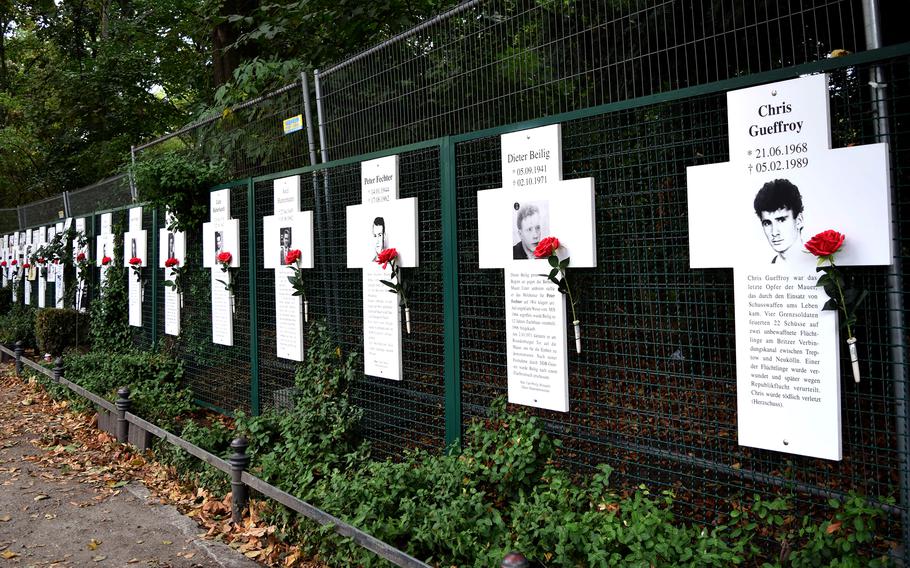
A simple but moving memorial to Wall victims in central Berlin, near the German Parliament building. (Gabriel Popkin/The Washington Post)
Telling the wall's story is challenging because many of the same people who created and brutally enforced the border had to be forgiven to reunite the country. The documentation could therefore be a bit bland, avoiding overt blame, but it nevertheless made clear that East German soldiers were willing, sometimes even eager, to kill their countrymen on behalf of a political system. It struck me that as we in the United States increasingly retreat into our seemingly irreconcilable ideological corners, the memorials may contain a valuable warning for us.
Thanks to my leisurely pace and the early nightfall, I had to abandon my hopes of completing the ride in a weekend (fortunately the Mauerweg stays within easy reach of Berlin's excellent transit network, and I was able to take the subway home), and instead finish the last 20 miles on a third day. Approaching the end of the ride, I finally left nature behind for a rapid-fire parade through some of Berlin's most famous spots. The first is Bösebrücke, where the wall was first breached. Robert Ide, then 14 and now an editor for the daily Tagesspiegel and manager of a community garden that once abutted the wall, was one of more than 20,000 jubilant people who streamed to the west on Nov. 9, 1989, and threw a wild, spontaneous party. He remembers it as the best night of his life.
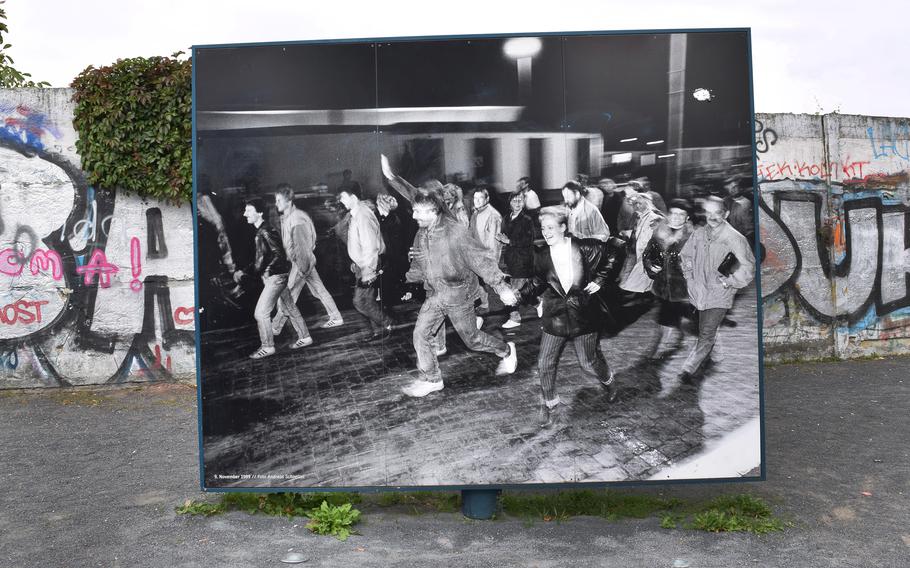
At Bösebrücke, where the Wall was first breached on the evening of November 9, 1989, an exhibit commemorates scenes of long-divided Berliners jubilantly greeting each other after nearly three decades of separation. (Gabriel Popkin/The Washington Post)
Shortly thereafter I got to the Mauerpark, which on a pleasant Sunday afternoon was filled with barbecues, sports, impromptu concerts, a wildly popular karaoke contest and a raucous drum circle that supercharged the air with sound. I know of no better representation of the freedom that has replaced the constraining, dream-crushing wall than this freewheeling bacchanal.
Just a few blocks farther on, there's a completely different mood at the somber Berlin Wall memorial at Bernauer Strasse. Here, apartment dwellers on the east side awoke Sunday, Aug. 13, 1961, to a barrier rising in the street in front of them, and some made dramatic early escape attempts. Some were successful; others ended tragically, including 58-year-old Ida Siekmann, who jumped three stories onto the sidewalk and later died from her injuries, making her the wall's first victim.
The path twists and turns, eventually heading across the Spree River and past the German parliament and the Brandenburg Gate, the backdrop for President Ronald Reagan's famous 1987 "tear down this wall" speech. Tourists posed for selfies, oblivious to the stones marking the wall path and perhaps of the wall itself. Then I passed uber-commercial Potsdamer Platz, Checkpoint Charlie with its East German kitsch and the gleaming Axel Springer headquarters, which once loomed over the wall and now holds fast to the trans-Atlantic relationship that saved West Berlin but seems to be receding into history.
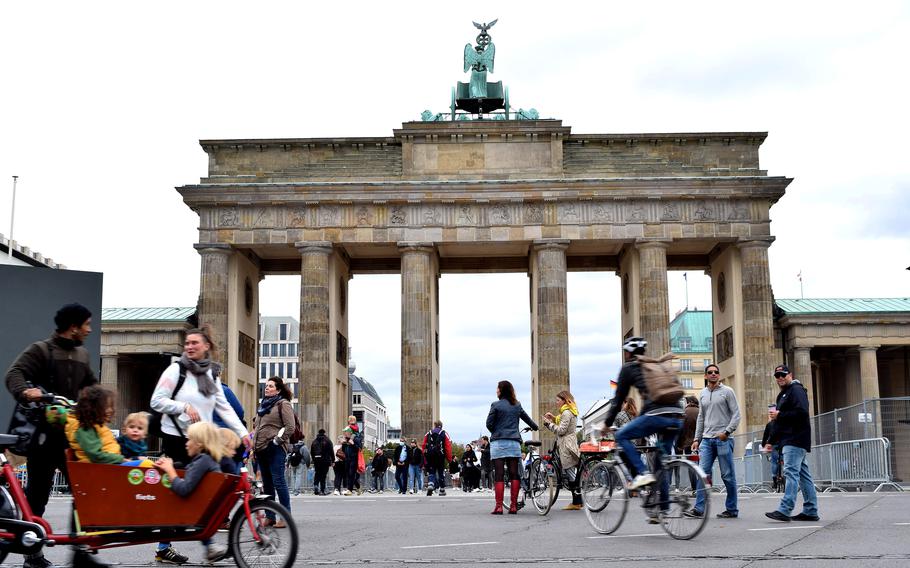
Tourists and Berliners stream past and through the Brandenburg Gate, which in 1987 served as the backdrop for Ronald Reagan’s famous “Tear Down This Wall” speech. A thin cobblestone strip in the foreground reveals the outer wall’s former path. (Gabriel Popkin/The Washington Post)
I crossed the river again to get to the East Side Gallery, the longest remaining stretch of intact wall. I've stopped by the site during periodic visits to Berlin over the past 20 years, and murals that in my memory were once genuinely provocative have largely been supplanted by ones with a more abstract, politically mushier style. Even more disappointing, a sizable chunk of the gallery had been swallowed by scaffolding for a riverfront high-rise. When I expressed shock during a tour a few weeks earlier that such a monument could be defiled by crass commercial interests, the guide abandoned his patient German and growled, in English, "Berlin has become a prostitute!"
And then, just like that, I was home. After riding the beautiful Oberbaumbrücke over the Spree back to Kreuzberg, I celebrated with a döner - the hearty Turkish shaved meat sandwich that's ubiquitous in Berlin - and beer from local joints on Köpenicker Strasse, a perfect microcosm of multicultural, ever-changing yet persistently weird and wonderful, emphatically forward-looking and reunited Berlin.
IF YOU GO
Where to stay
Pension am Tiefen See
Berliner Strasse 58, Potsdam
011-49-331-24-02-22
Eclectic, no-frills but comfortable hotel on the Tiefer See lake. Sumptuous breakfast available. Rooms from about $50 per night, depending on season. Houseboat stays also possible.
Where to eat
Garage du Pont
Berliner Strasse 88, Potsdam
011-49-331-870-932-72
Restaurant with retro aesthetic serving tarte flambée, a specialty of the French Alsace region bordering Germany, and other French-inspired dishes. Open Thursday to Sunday noon to 11 p.m. Entrees from about $13.50.
What to do
Berlin Wall Trail
Berlin
berlin.de/mauer/en/wall-trail/
A 100-mile, mostly well-signed bicycling and walking route tracing the former path of the Berlin Wall. Frequent historical displays and memorials give a vivid sense of how this infamous structure, which surrounded West Berlin from 1961 to 1989, affected both world history and Germans' daily lives. Download a map to plan your route. Mostly paved with some unpaved stretches. Open 24/7. Free.
Information: germany.travel/en/home.html